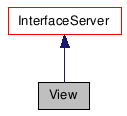Detailed Description
This class is passed in to GeomObject::GetRenderMesh() to allow objects to do view dependent rendering.
It is also passed to Control::EvalVisibility(). For example particle systems use this to have the particles exactly face the camera (if this option is enabled). If GetRenderMesh() is called by the renderer, the methods of this class are implemented by the system. If a plug-in is calling this method, they must implement these methods. The sample code below shown a null implementation that may be used if a viewport is not involved:
class NullView : public View { Point2 ViewToScreen(Point3 p) { return Point2(p.x,p.y); } NullView() { worldToView.IdentityMatrix(); screenW=640.0f; screenH = 480.0f; } };
- See also:
- GeomObject, Interface, Control, Matrix3, Point3
#include <object.h>

Public Member Functions |
|
| virtual Point2 | ViewToScreen (Point3 p)=0 |
| This method is used to convert a point in
view space to screen space. |
|
| virtual BOOL | CheckForRenderAbort () |
| This method should be used by
GetRenderMesh() implementations that require a lot of processing
time. |
|
| virtual INT_PTR | Execute (int cmd, ULONG_PTR arg1=0, ULONG_PTR arg2=0, ULONG_PTR arg3=0) |
| Generic expansion function. |
|
| View () | |
Public Attributes |
|
| float | screenW |
| The screen width in pixels. |
|
| float | screenH |
| The screen height in pixels. |
|
| Matrix3 | worldToView |
| A transformation matrix from world into view
space. |
|
| int | projType |
| The view projection type: 0 is perspective,
1 is parallel. |
|
| float | fov |
| The field of view in radians. |
|
| float | pixelSize |
| The pixel size setting. |
|
| Matrix3 | affineTM |
| World to camera transformation matrix.
|
|
| DWORD | flags |
| Defined in Flags
for the View class. |
|
Constructor & Destructor Documentation
| View | ( | ) | [inline] |
{ projType = -1; flags = RENDER_MESH_DISPLACEMENT_MAP; } // projType not set, this is to deal with older renderers.
Member Function Documentation
This method is used to convert a point in view space to screen space.
This includes any perspective projection.
- Parameters:
-
p The point in view space.
- Returns:
- The point in screen space (in pixel coordinates).
| virtual BOOL CheckForRenderAbort | ( | ) | [inline, virtual] |
This method should be used by GetRenderMesh() implementations that require a lot of processing time.
This allows these processes to be interrupted by the user. An example of this in use is the extensive computations done for displacement mapping. These may be interrupted by the user during a render. So, any implementation of GetRenderMesh() which takes a long time should periodically call this method to see if the user has canceled the render.
- Returns:
- true if user has canceled, false otherwise.
{ return FALSE; }
| virtual INT_PTR Execute | ( | int | cmd, |
| ULONG_PTR | arg1 = 0, |
||
| ULONG_PTR | arg2 = 0, |
||
| ULONG_PTR | arg3 = 0 |
||
| ) | [inline, virtual] |
Member Data Documentation
| float screenW |
The screen width in pixels.
| float screenH |
The screen height in pixels.
A transformation matrix from world into view space.
This is into the camera's space.
| int projType |
The view projection type: 0 is perspective, 1 is parallel.
| float fov |
The field of view in radians.
| float pixelSize |
The pixel size setting.
World to camera transformation matrix.
| DWORD flags |
Defined in Flags for the View class.
